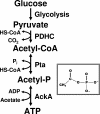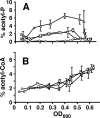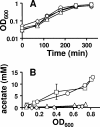The intracellular concentration of acetyl phosphate in Escherichia coli is sufficient for direct phosphorylation of two-component response regulators
- PMID: 17545286
- PMCID: PMC1951799
- DOI: 10.1128/JB.00564-07
The intracellular concentration of acetyl phosphate in Escherichia coli is sufficient for direct phosphorylation of two-component response regulators
Abstract
Acetyl phosphate, the intermediate of the AckA-Pta pathway, acts as a global signal in Escherichia coli. Although acetyl phosphate clearly signals through two-component response regulators, it remains unclear whether acetyl phosphate acts as a direct phospho donor or functions through an indirect mechanism. We used two-dimensional thin-layer chromatography to measure the relative concentrations of acetyl phosphate, acetyl coenzyme A, ATP, and GTP over the course of the entire growth curve. We estimated that the intracellular concentration of acetyl phosphate in wild-type cells reaches at least 3 mM, a concentration sufficient to activate two-component response regulators via direct phosphoryl transfer.
Figures






Similar articles
-
Regulation of RssB-dependent proteolysis in Escherichia coli: a role for acetyl phosphate in a response regulator-controlled process.Mol Microbiol. 1998 Feb;27(4):787-95. doi: 10.1046/j.1365-2958.1998.00725.x. Mol Microbiol. 1998. PMID: 9515704
-
Involvement of phosphotransacetylase, acetate kinase, and acetyl phosphate synthesis in control of the phosphate regulon in Escherichia coli.J Bacteriol. 1992 Apr;174(7):2124-30. doi: 10.1128/jb.174.7.2124-2130.1992. J Bacteriol. 1992. PMID: 1551836 Free PMC article.
-
Regulation of acetyl phosphate synthesis and degradation, and the control of flagellar expression in Escherichia coli.Mol Microbiol. 1994 Jun;12(6):973-84. doi: 10.1111/j.1365-2958.1994.tb01085.x. Mol Microbiol. 1994. PMID: 7934904
-
Physiologically relevant small phosphodonors link metabolism to signal transduction.Curr Opin Microbiol. 2010 Apr;13(2):204-9. doi: 10.1016/j.mib.2010.01.002. Epub 2010 Jan 29. Curr Opin Microbiol. 2010. PMID: 20117041 Free PMC article. Review.
-
Is acetyl phosphate a global signal in Escherichia coli?J Bacteriol. 1993 May;175(10):2793-8. doi: 10.1128/jb.175.10.2793-2798.1993. J Bacteriol. 1993. PMID: 8491699 Free PMC article. Review. No abstract available.
Cited by
-
Response regulator PorX coordinates oligonucleotide signalling and gene expression to control the secretion of virulence factors.Nucleic Acids Res. 2022 Nov 28;50(21):12558-12577. doi: 10.1093/nar/gkac1103. Nucleic Acids Res. 2022. PMID: 36464236 Free PMC article.
-
Instability of ackA (acetate kinase) mutations and their effects on acetyl phosphate and ATP amounts in Streptococcus pneumoniae D39.J Bacteriol. 2010 Dec;192(24):6390-400. doi: 10.1128/JB.00995-10. Epub 2010 Oct 15. J Bacteriol. 2010. PMID: 20952579 Free PMC article.
-
Short-term differential adaptation to anaerobic stress via genomic mutations by Escherichia coli strains K-12 and B lacking alcohol dehydrogenase.Front Microbiol. 2014 Sep 9;5:476. doi: 10.3389/fmicb.2014.00476. eCollection 2014. Front Microbiol. 2014. PMID: 25250024 Free PMC article.
-
Streptococcal antagonism in oral biofilms: Streptococcus sanguinis and Streptococcus gordonii interference with Streptococcus mutans.J Bacteriol. 2008 Jul;190(13):4632-40. doi: 10.1128/JB.00276-08. Epub 2008 Apr 25. J Bacteriol. 2008. PMID: 18441055 Free PMC article.
-
Bacteria employ lysine acetylation of transcriptional regulators to adapt gene expression to cellular metabolism.Nat Commun. 2024 Feb 23;15(1):1674. doi: 10.1038/s41467-024-46039-8. Nat Commun. 2024. PMID: 38395951 Free PMC article.
References
-
- Bang, I. S., J. P. Audia, Y. K. Park, and J. W. Foster. 2002. Autoinduction of the ompR response regulator by acid shock and control of the Salmonella enterica acid tolerance response. Mol. Microbiol. 44:1235-1250. - PubMed
-
- Bertagnolli, B. L., and L. P. Hager. 1991. Activation of Escherichia coli pyruvate oxidase enhances the oxidation of hydroxyethylthiamin pyrophosphate. J. Biol. Chem. 266:10168-10173. - PubMed
-
- Bertagnolli, B. L., and L. P. Hager. 1993. Role of flavin in acetoin production by two bacterial pyruvate oxidases. Arch. Biochem. Biophys. 300:364-371. - PubMed
-
- Bochner, B. R., and B. N. Ames. 1982. Complete analysis of cellular nucleotides by two-dimensional thin layer chromatography. J. Biol. Chem. 257:9759-9769. - PubMed
-
- Bochner, B. R., and B. N. Ames. 1982. Selective precipitation orthophosphate from mixtures containing labile phosphorylated metabolites. Anal. Biochem. 122:100-107. - PubMed
Publication types
MeSH terms
Substances
Grants and funding
LinkOut - more resources
Full Text Sources
Molecular Biology Databases

